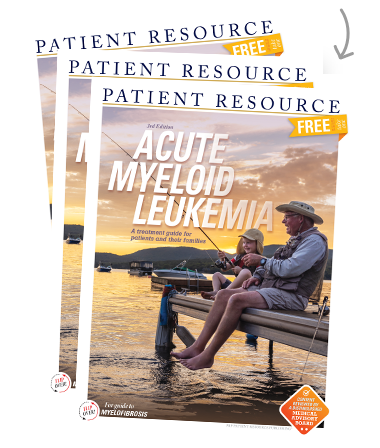Acute Myeloid Leukemia
Overview
People whose lives are affected by acute myeloid leukemia (AML), an aggressive hematologic (blood) cancer, have reason to be optimistic about the future. Advances in the last decade have led to several new treatment approvals by the U.S. Food and Drug Administration (FDA). Immense effort toward understanding specific chromosome changes and molecular alterations, and the development of therapies and treatment combinations targeting these abnormalities, have fueled the progress.
AML is a rare disorder. Depending on the unique characteristics of your diagnosis, you may have to make treatment decisions quickly. To ensure you feel informed, consult with an AML specialist or a cancer center known for treating it. You will benefit from their experience. If a specialist is not nearby and traveling for treatment is not an option, look for one who will provide a second opinion and/or consult with your doctor. A second opinion can confirm the diagnosis, prognosis and suggested treatment plan or add other information to consider.
About AML
AML is a type of leukemia that begins in early myeloid cells, which normally mature to become white blood cells (with the exception of lymphocytes), red blood cells or platelets. Instead of developing into these normal blood elements, they grow uncontrollably, creating an excess of abnormal myeloid cells that crowd out healthy blood-forming cells in the bone marrow. The few healthy blood-forming cells cannot keep up, resulting in low numbers of healthy white blood cells, red blood cells and platelets. This increases the risk for infection, anemia and excessive bruising and/or bleeding.
The “acute” in AML means it grows quickly. Other forms of leukemia are categorized as “chronic,” which means slow growing. AML is sometimes referred to as acute myeloid, myelocytic or myeloblastic leukemia and is described as untreated, in remission or recurrent.
Diagnosing AML
Your doctor will order tests to diagnose your condition and recommend the best treatment plan. You may have blood tests, bone marrow aspiration and biopsy, a lumbar puncture and/or imaging tests. Specialized tests, such as flow cytometry, fluorescence in situ hybridization (FISH), next-generation sequencing and reverse transcription-polymerase chain reaction (RT-PCR), will likely be used to identify the proteins, chromosomes, genes and other factors involved in leukemia, as well as determine the subtype.
Your doctor will refer to the World Health Organization (WHO) Classification System (see Table 1). It classifies AML into subtypes based on the appearance of the leukemia cells under a microscope, as well as the presence or absence of certain chromosome (cytogenetic) abnormalities and/or molecular (genetic) mutations found in the leukemia cells. This distinction is important because each subtype has specific symptoms and can behave differently after treatment.
These abnormalities can be numerical or structural. A numerical abnormality is when a different number of chromosomes in the cells than is normal is present. For example, instead of the typical 46 chromosomes in each cell of the body, there may be 45 or 47 chromosomes. A structural abnormality means the chromosome’s structure has been altered in one of several ways.
Some of the molecular genetic changes linked to AML include ASXL1, CEBP alpha, FLT3, IDH1, IDH2, NPM1, RUNX1 and TP53 (see Table 1 for additional mutations). Targeted therapies are approved to treat certain AML genetic mutations. Not all genetic mutations are always present during diagnostic testing, so your doctor will likely retest if the disease relapses (returns).
Certain genetic mutations are associated with a better prognosis than others. Some mutations respond better to certain types and dosages of drug therapy. Still others may influence the timing of, or need for, a stem cell transplant.
| Table 1 - WHO Classification System | |
|
AML with recurrent genetic abnormalities
Subtypes: |
|
| AML with myelodysplasia-related changes | |
| Therapy-related myeloid neoplasms | |
|
AML not otherwise specificed (includes cases that do not fall into any other group; similar to the FAB classification system)
Subtypes: |
|
| Myeloid sarcoma | |
|
Undifferentiated or biphenotypic acute leukemias (leukemias that have both lymphocytic and myeloid features; also called ALL with myeloid markers, AML with lymphoid markers, or mixed lineage leukemia)
| |
| Used with permission of the American Joint Committee on Cancer (AJCC), Chicago, Illinois. The original and primary source for this information is the AJCC Cancer Staging Manual, Eighth Edition (2017) published by Springer Science+Business Media. | |



